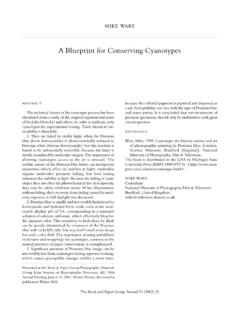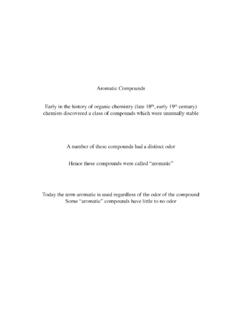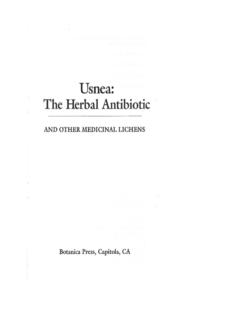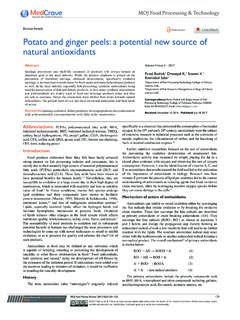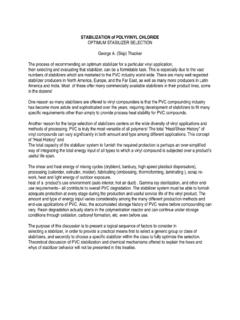Transcription of by Alan Phenix Generic Hydrocarbon Solvents: a …
1 WAAC Newsletter Volume 29 Number 2 May 200713matic constituents of the original feedstock into saturated compounds, with the result that such grades often contain very few or no note about CAS Registry and EINECS NumbersWhen it comes to specifying any chemical substance, a good starting point is the CAS Registry Numbers or, for Europe, the EINECS (European Inventory of Existing Commercial Chemical Substances) number, which is also sometimes called the EC In principle, these registries of chemical substances provide an indexed catalogue of spe-cific chemical compounds: known chemical substances even different individual isomers of the same substance - are identified by a unique registration number.
2 To take xylene, for example, this substance is covered by four dif-ferent CAS Registry and EINECS numbers: Hydrocarbon solvents are just one, relatively small, group of products that are the output of petroleum refineries. Like the various fuel products derived from crude petroleum (gasoline, kerosene, fuel oil, etc.) most Hydrocarbon sol-vents are complex mixtures rather than specific individual compounds. So the approach adopted for formal descrip-tion and differentiation of petroleum refinery products was a series of Generic descriptors for different refinery process streams, each with its own CAS Registry Number (and by correlation, now, EC/EINECS Number), based not on chemical composition, but on the process history and final process step.
3 The result is that over 80 CAS Numbers exist which describe different kinds of petroleum refinery output, many of which might apply to commercial solvent products. The essential point of relevance to solvent products is that CAS Registry Numbers for petroleum refinery products are not necessarily unique descriptors of the chemical sub-stance: refinery products with the same or substantially similar compositions may actually have different CAS num-bers; furthermore, more than one CAS Registry Number may apply to any given product. CAS Registry and EC Numbers can be helpful in providing some clarification of the composition of Hydrocarbon solvents , but they should All of us, no doubt, have encountered and used Generic Hydrocarbon solvents from the hardware store or chemi-cal supply house.
4 But how often, as we contemplated our bottle of mineral spirits, naphtha, white spirits, petroleum spirits, turps substitute, mineral turpentine, benzine, petro-leum ether, ligroin, or Stoddard Solvent, have we felt that we actually knew what was in it, and what were its proper-ties in terms of solvent power, boiling range, evaporation rate, etc. Although conservators are becoming increasingly accus-tomed to proprietary Hydrocarbon solvents offered by the larger petrochemical companies Shell, Exxon Mobil, etc. - and are seeking out particular products with quite spe-cific properties, the traditional Generic solvents still arouse some considerable uncertainty regarding composition and properties.
5 The vagaries of nomenclature of Generic Hydrocarbon sol-vents became painfully apparent to me during the course of early work on a book on the use of solvents in conser-vation which is currently in progress: the situation seemed so unclear to me that I felt it necessary, for my own un-derstanding and peace of mind, to try to untangle some of the web of confusion concerning the identity of all of the kinds of stuff we know of as Generic Hydrocarbon solvents . The following article is essentially an extract of some of the content of the draft chapter in the book which is concerned with Hydrocarbon is perhaps worth mentioning at the outset that the princi-pal ways in which these kinds of product are distinguished are by their boiling/distillation ranges (and, by associa-tion, volatility, flash point etc.)
6 And aromatic content; these are the key properties which we should have some idea of when using such liquids. Generally speaking, with regard to aromatic content, Generic Hydrocarbon solvents fall into two broad groups: those that are essentially aliphatic (ie. composed largely of linear, branched, and/or cyclic alkanes) and free from aromatic compounds, and those that contain low to moderate proportions of aro- matics, usually less than about 25%.The presence of a fraction of aromatic compounds in an otherwise aliphatic Hydrocarbon solvent will add to its po-larity and solvent power, factors which may be desirable for certain purposes, for example dissolving certain poly-mer resins.
7 The presence of a significant aromatic content in a largely aliphatic Hydrocarbon liquid may, however, have some less desirable consequences, such as increased odor or greater degree of harmfulness. Traditional mineral spirits or white spirits products normally have aromatic contents in the range of about 10-25% w/w. Quite a number of Hydrocarbon solvent products will have been actively de-aromatized to re-move or chemically convert (by hydrogenation) the aro- Generic Hydrocarbon solvents : a Guide to Nomenclature1. A good online source for finding CAS Registry numbers is the ChemIDplus database operated by the US National Library of Medicine.
8 See: , a database of chemical substances searchable by CAS Registry and EINECS numbers is provided by the European Chemical Substances Information System (ESIS) operated by the European Chemicals Bureau; see xylene: mixed, o-xylene p-xylene m-xylene or no specific isomersCAS 1330-20-7 95-47-6 106-42-3 108-38-3 Registry No. 215-535-7 202-422-2 203-396-5 203-576-3by Alan Phenix14 WAAC Newsletter Volume 29 Number 2 May 2007be treated with some caution, especially if one is using them to source information on health hazards, Stoddard Solvent is a good example: Stoddard Solvent has its own CAS Registry No.
9 8052-41-3, but one may also encounter products called Stoddard Solvent which are assigned other CAS numbers, such as 64742-88-7 which identifies it as Solvent naphtha, petroleum, medium aliphatic, as well as several other descriptors. Low boiling point, low aromatics (or aromatics-free) Generic Hydrocarbon solvents : naphthas, petroleum spirit, petroleum benzine, ligroin, petroleum ether, and related productsThe terms petrol or gasoline are used in the petroleum industry to describe the broad fraction of volatile hydrocar-bons that are distilled from crude oil between 30 and 210 C; but from this very broad fraction a whole variety of sub-fractions can be isolated and/or are marketed as solvents .
10 At the lower end of this boiling range we find liquids that would come under the broad designation of naphtha or pe-troleum spirits. These two somewhat over-arching terms correctly describe some of the more volatile liquid frac-tions of petroleum: naphtha normally applies to refined or partly refined products of distillation of crude oil boiling in the range of approximately 40 to 100 C, or possibly a little higher to around 120 C. Having said this, however, the term naphtha does, somewhat confusingly, also get used in the names of some petroleum-derived products that have boiling ranges sometimes quite considerably higher than 120 C, as we shall see below.
